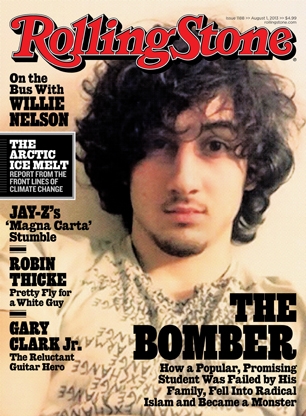Last night I came home from San Diego Comic-Con Day 1 to find the newest Rolling Stone open, facedown on the living room carpet; the controversial cover, with Boston Marathon bomber Dzhokhar Tsarnaev, stared up like Jim Morrison. I had heard about the controversy over the photo, and accusations that the magazine somehow glorified the bomb suspect, for days. So had my wife, who finished Janet Reitman’s riveting account, soon as we both settled in for the evening.
Anne never reads Rolling Stone. But the cover caught her attention enough that she consumed this one article, neglecting the New Yorker, which also arrived in the mail yesterday, coincidentally containing a smart editorial defending RS editors. She doesn’t approve of the cover, and yet it clearly was effective enough. As an editor, I must commend Rolling Stone for doing with a picture what tabloids like the New York Post or online aggregator Huffington Post does with snarky headlines: Get people to read the story.
Too much content compete’s for readers’ attention. So much good journalism is awash in a tsunami of news aggregation, blog rumormongering and social network gossip. News organizations with compelling content need to be more aggressive than ever. RS editors wisely chose a captivating photo, “one that other news outlets, including the New York Times and Washington Post, had previously published. It does not appear that the magazine altered the image in any meaningful way”, New Yorker’s Ian Crouch observes.
There are reasons why so many print publications put people on the cover. We identify with ourselves. Rolling Stone has a long tradition of effective photography, inside as well as the cover. The image’s controversy isn’t about doctoring or editorial manipulation but what the photo represents. I agree with Crouch: “What is so troubling about this image, and many of the others that have become available since April, is that Tsarnaev really does look like a rock star”.
RS editors make the same point from a different perspective: “The fact that Dzhokhar Tsarnaev is young, and in the same age group as many of our readers, makes it all the more important for us to examine the complexities of this issue and gain a more complete understanding of how a tragedy like this happens”.
Right.
“It wasn’t just the photo. I want to know more about him”, my wife tells me today. Surely people who are closer to Tsamaey’s age feel similarly, too. There are so many questions why someone so young, so handsome and so seemingly innocent conspired to so ruthlessly hurt other people.
The photo evokes both professional and amateur qualities, and there’s something about it that is as much the kind of self-portraits people take with their phones as the rock star look. The self-portrait makes the image all the more familiar and intriguing to a generation that SnapChats and Instagrams.
Someone needs to explain how, as Reitman writes, “captain of the Cambridge Rindge and Latin wrestling team for two years and a promising student” and “just a normal American kid” turned bomber; terrorist. The photo portrait of the young man doesn’t immediately reconcile with his behavior. What you see could be a rock star. What you have is a fallen star, in the eyes of so many who knew this young man and ask same question why.
As a native New Englander, I feel deeply about the Boston Marathon bombing. But I also am an editor, journalist and writer. As a professional, my hat tips to Rolling Stone. The story is superbly reported and written, pointed at the right audience and illustrated compellingly.
